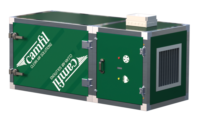Snack Food & Wholesale Bakery was recently able to talk to Scott Houtz, president, Air Management Technologies Inc., about some best practices that snack and bakery companies can implement for air management.
Liz Parker: How can air management improve quality control?

Scott Houtz
LP: How can air management maintain environments for better food safety?
SH: Food safety professionals recognize the importance of environmental control for better food safety and during the past decade significant advancements have been made. Some of the more common measures include pressurizing the facility in relationship to the outdoors and installing enhanced air filtration on systems that supply air to the facility which reduces the level of molds and other airborne contaminants and insects. Where finished product zones can be established, special systems are integrated to provide even more focused efforts that include cooling and humidity control measures. Implementing this “cleanroom” concept normally entails higher levels of air filtration and UV Lighting, as well as product consistency, whether it is July or January, which also helps promote product resistance to molds, etc. In many cases this “cleanroom” concept is the best investment when considering the complexity of facility wide control in both initial capital and operation expenses. Where facilities have the need for freezing and or cooling operations humidity control is essential to keep moisture droplets from forming at the inlets and outlets that could lead to microbial contamination. The solution is many times a conditioned vestibule that once again allows a focused effort rather than trying to implement control throughout the entire facility.
LP: How does ventilation affect food safety?
SH: In most facilities most of the ventilation that is delivered is to satisfy Occupant Heat Stress requirements which this summer has been a hot one for sure. Since most of the molds originate from the outdoors it only makes sense that the more airflow delivered increases the potential for issues and for this reason you will more air-conditioned facilities in the future that require less than half the airflow as ventilation systems while improving the environment for the workforce. Having the proper and consistent building pressure also has a direct impact the efficient operation of ovens and other process supporting equipment.
LP: What are some “best practices” for air management? What about during cooling, and between ovens/packaging?
SH: Oven is considered a “kill zone” in many cases but the time spent traveling from the oven till the product is packaged is when its most susceptible to molds and other airborne contaminants.
LP: Any advice for snack/bakery facilities for best practices in air management?
SH: It is important to understand the “why” when investing in industrial HVAC systems and that the benefits can be lost literally overnight without proper oversight. Having a monitoring system in place that provides alerts when key Environmental Performance Indicators (EPI’s) are not being met is essential to protect your investment and assure effective air management for the long-term.





